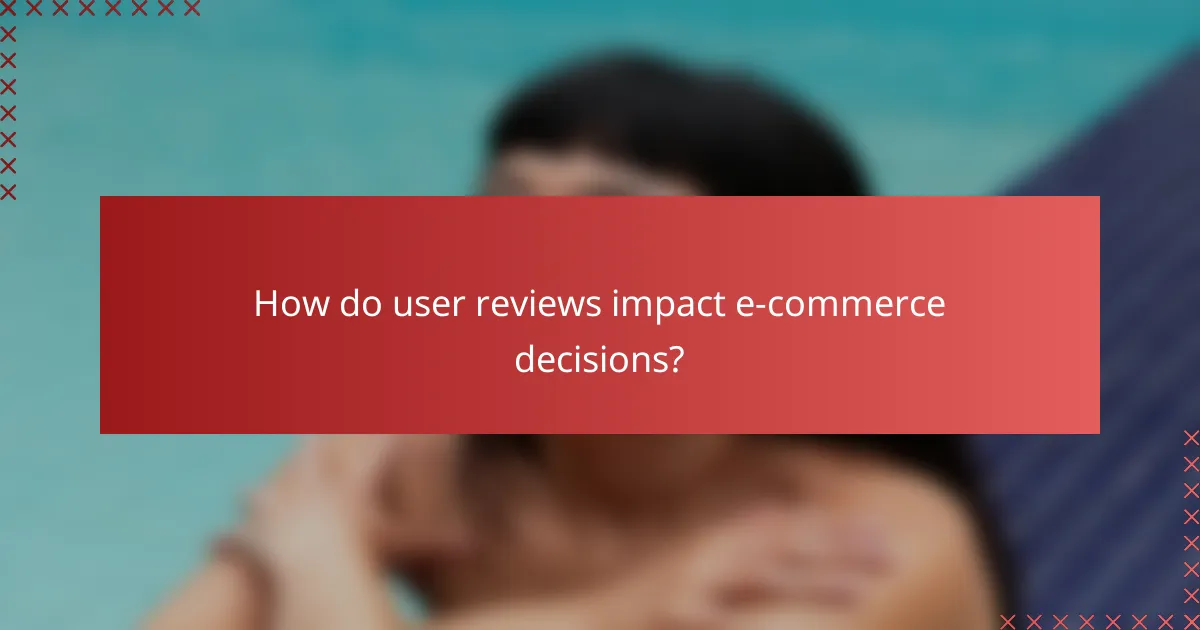User reviews play a crucial role in shaping consumer perceptions and guiding purchasing decisions in the e-commerce landscape. To ensure the authenticity of these reviews, it is essential to focus on indicators such as verified purchases and the language used, while also leveraging third-party verification tools. By sourcing reviews from reputable platforms, consumers can gain valuable insights into product quality and brand reliability.

How to verify user reviews for authenticity?
To verify user reviews for authenticity, focus on indicators that suggest a review is genuine rather than fabricated. This involves checking for verified purchases, analyzing the language used in reviews, and utilizing third-party verification tools.
Check verified purchase indicators
Verified purchase indicators confirm that the reviewer has actually bought the product. Look for labels such as “Verified Purchase” on platforms like Amazon, which signal that the review comes from a legitimate buyer.
Additionally, consider the timing of the review. Reviews posted shortly after a product’s release may be more reliable if they come from verified purchases, as they reflect immediate user experiences.
Analyze review patterns and language
Examine the language and patterns in the reviews. Authentic reviews often contain specific details about the product, while fake ones may use generic phrases or overly positive language without substance.
Look for patterns in reviewer behavior, such as multiple reviews from the same user in a short time frame or a sudden spike in positive reviews. These can indicate manipulation or inauthenticity.
Use third-party verification tools
Third-party verification tools can help assess the authenticity of user reviews. Websites like Fakespot and ReviewMeta analyze reviews for signs of manipulation and provide a reliability score.
Using these tools can save time and provide insights into the credibility of reviews, helping you make more informed purchasing decisions. Always cross-reference findings with other sources for the best results.

What are the best sources for user reviews?
The best sources for user reviews include retailer websites, consumer review platforms, and social media channels. Each source offers unique insights and levels of authenticity that can help consumers make informed decisions.
Retailer websites like Amazon
Retailer websites, especially large platforms like Amazon, provide a vast array of user reviews directly associated with products. These reviews can be filtered by date, rating, and helpfulness, allowing potential buyers to gauge the latest feedback and overall satisfaction.
However, it’s essential to be cautious of fake reviews, which can skew perceptions. Look for verified purchase badges and a mix of positive and negative reviews to assess authenticity.
Consumer review platforms like Trustpilot
Consumer review platforms such as Trustpilot specialize in collecting and displaying user feedback across various businesses and services. These platforms typically have strict guidelines to ensure that reviews are genuine, which adds a layer of credibility.
When using these platforms, check the overall rating and read a selection of reviews to understand common themes. Be aware that some businesses may solicit positive reviews, which can affect the balance of feedback.
Social media channels
Social media channels like Facebook, Twitter, and Instagram serve as informal yet valuable sources for user reviews. Users often share their experiences and opinions on these platforms, providing real-time feedback and insights.
To leverage social media reviews, follow relevant hashtags and engage with posts about products or services. Keep in mind that these reviews can be subjective and may not always reflect a comprehensive view, so consider them alongside more formal sources.

How do user reviews impact e-commerce decisions?
User reviews significantly influence e-commerce decisions by shaping consumer perceptions and guiding purchasing behavior. They serve as a critical source of information, helping potential buyers assess product quality and brand reliability.
Influence on purchase decisions
User reviews play a pivotal role in determining whether a customer will proceed with a purchase. Studies suggest that a majority of consumers read reviews before making a decision, often relying on them to validate their choices. Positive reviews can lead to increased sales, while negative feedback can deter potential buyers.
To maximize the impact of reviews, businesses should encourage satisfied customers to leave feedback. Simple strategies include follow-up emails after purchase or offering incentives for reviews. However, it’s crucial to ensure authenticity to maintain trust.
Effect on brand reputation
The accumulation of user reviews directly affects a brand’s reputation. A strong collection of positive reviews can enhance a brand’s image, while a few negative comments can tarnish it. Brands must actively monitor their online presence and respond to reviews to manage their reputation effectively.
Brands should adopt a proactive approach by addressing negative reviews promptly and professionally. This can demonstrate commitment to customer satisfaction and potentially turn a dissatisfied customer into a loyal one. Regularly showcasing positive reviews on websites and social media can further bolster brand credibility.

What criteria should you consider when reading reviews?
When reading reviews, consider the credibility of the reviewer, the recency of the reviews, and the overall volume of reviews. These factors help assess the authenticity and reliability of the information presented.
Reviewer credibility
Reviewer credibility refers to the trustworthiness and expertise of the individual providing the review. Look for reviews from verified purchasers or those with a history of providing detailed and balanced feedback. Check if the reviewer has a profile that indicates their experience with the product or service.
Be cautious of reviews from anonymous users or those with vague profiles, as they may lack accountability. A credible reviewer often provides specific details about their experience, which can help you gauge the product’s quality.
Recency of reviews
The recency of reviews is crucial because products and services can change over time. A review from a few months ago may be more relevant than one from several years back, especially in fast-evolving industries like technology or fashion.
Look for a mix of recent reviews to get a balanced perspective. If most reviews are outdated, consider seeking out newer products or services that may better meet current standards and user expectations.
Volume of reviews
The volume of reviews can indicate the popularity and reliability of a product or service. A higher number of reviews generally suggests that more people have tried the item, which can lead to a more accurate average rating.
However, be wary of products with an unusually high number of overly positive reviews, as this could indicate manipulation. Aim for products with a substantial number of reviews, ideally in the hundreds or thousands, to ensure a more trustworthy assessment.

How to identify fake reviews?
Identifying fake reviews involves recognizing certain patterns and language that indicate inauthenticity. By being vigilant about the wording and the behavior of reviewers, you can better discern genuine feedback from misleading content.
Look for overly positive or negative language
Reviews that contain excessively positive or negative language can be a red flag for authenticity. Phrases like “best product ever” or “absolutely terrible” often lack the nuance of real experiences. Genuine reviews typically include a mix of pros and cons, providing a balanced view.
Consider the emotional tone of the review. If it feels exaggerated or overly enthusiastic without specific details, it may be fabricated. Authentic reviews usually mention particular features or experiences that support their claims.
Check for suspicious review patterns
Analyzing review patterns can help you spot fake entries. Look for reviews that are posted in rapid succession or from accounts with little history. If multiple reviews appear on the same day or week, especially for a newly launched product, this may indicate manipulation.
Additionally, be cautious of reviews that use similar phrasing or structure. If several reviews sound alike or come from users with generic usernames, they might not be trustworthy. Authentic reviews often reflect diverse perspectives and writing styles.

What are the legal implications of fake reviews?
Fake reviews can lead to significant legal consequences for businesses, including fines and lawsuits. Misleading consumers through false testimonials violates consumer protection laws and can damage a company’s reputation.
Consumer protection laws
Consumer protection laws are designed to safeguard buyers from deceptive practices, including fake reviews. In many jurisdictions, such as the United States and the European Union, these laws prohibit false advertising and misleading representations about products or services.
Businesses found guilty of violating these laws may face penalties, including fines that can range from hundreds to thousands of dollars, depending on the severity of the offense. It’s crucial for companies to ensure that all reviews are authentic and accurately reflect customer experiences.
Regulatory actions against businesses
Regulatory bodies actively monitor and enforce compliance with consumer protection laws regarding reviews. In the U.S., the Federal Trade Commission (FTC) has guidelines that require businesses to disclose any material connections with reviewers.
Failure to comply can result in investigations and sanctions, including hefty fines or even legal action. Companies should regularly audit their review practices and implement verification processes to avoid potential regulatory issues.

How to encourage authentic user reviews?
Encouraging authentic user reviews involves creating an environment where customers feel comfortable sharing their honest opinions. This can be achieved through transparency, effective communication, and incentives that promote genuine feedback.
Incentivize honest feedback
Incentivizing honest feedback can motivate customers to share their experiences. Consider offering small rewards, such as discounts or loyalty points, for leaving a review. Ensure that these incentives do not compromise the authenticity of the feedback.
Be clear about the type of feedback you are seeking. Encourage customers to provide detailed insights about their experiences, rather than just star ratings. This can help you gather more meaningful information that can be used to improve your products or services.
Common pitfalls include offering incentives only for positive reviews, which can lead to biased feedback. Instead, focus on creating a balanced approach that values all types of reviews, as this will enhance credibility and trust in your brand.
